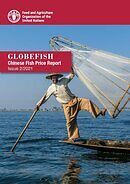Publications
The FAO GLOBEFISH Chinese Fish Price Report, based on information supplied by industry correspondents, aims to provide guidance on broad price trends. In the last years, China remained the top fish producer in the world with strong linkages with this historical evolution growth of aquaculture vis-à-vis wild capture fisheries. In addition, China is a country where international trade plays a significant role in fish and fish products. The Chinese Fish Price Report fills an existing gap...
The classification of products is a key element in international trade. The Harmonized System (HS) of the World Customs Organization (WCO) provides an internationally recognised system of product classification. It is used for many purposes, including import duties, rules of origin, freight documents and statistics.
Fish is often one of the most complex commodities to classify, with several specificities. There is a multiplicity of phyla, species, and treatments, which create an intricate set of different layers...
This report is an update of the status of the global seaweed market: production figures from culture and capture, the size of the international market for seaweed and its commercially important extracts, the leading nations by region, developments in processing and utilization technology, and innovations in the industry, as well as the challenges and outlook for the industry.
As it is not possible to feature all individual countries of importance in the seaweed sector, several have been selected as being representative...
Commodity updates from around the world on prices, production, processing, imports, and exports for the main fish commodities. This information is collated at GLOBEFISH, the FAO centre for international fish trade information. The information is taken form the network of GLOBEFISH correspondents, the European Price Report, GLOBEFISH Highlights, INFOFISH Trade News, FAO FISHDAB, EUROSTAT and others.
Read on issuu:
This publication is intended to complement and inform the International Plan of Action for the Conservation and Management of Sharks, developed in 1998 to address concerns over possible negative effects of increased shark catches on vulnerable shark populations.
It is also intended as a part complement to, and part continuation of, Shark Utilization, Marketing and Trade (FAO Fisheries Technical Paper No. 389), published in 1999. Much of that paper remains valid, e.g. the information on product utilization...






